When choosing a portable charge detection monitor system, you'll want to focus on key safety features and compatibility requirements. Look for systems that include overcharge protection, temperature monitoring, and real-time data tracking capabilities. Your ideal system should support multiple battery configurations (12V-48V) and incorporate smart charging algorithms that adjust to different battery chemistries. Make sure it offers remote monitoring through web-based interfaces and includes essential protection circuits for voltage, current, and temperature. Consider the IP54 protection rating for durability and check that the system meets relevant compliance standards. The following information will equip you with deeper technical insights for making an informed decision.
Key System Components
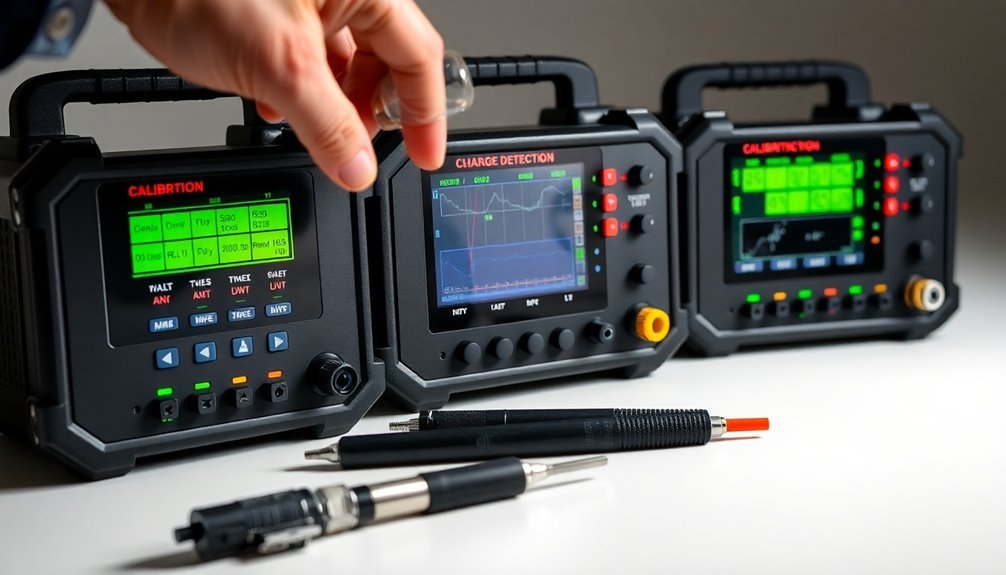
Four indispensable hardware components form the foundation of a portable charge detection monitor system. The buck-boost or battery-charger IC enables pack charging with multiple modes including trickle, pre-charging, constant-current, and constant-voltage, while incorporating safety timers to prevent overcharging. It works closely with your battery management MCU, which monitors charging and provides vital cutoff protection. Modern systems utilizing USB PD modules can negotiate power delivery up to 100W for enhanced charging capabilities.
You'll need sensors and analog peripherals to track system and battery temperatures. These components include a 12-bit SAR ADC for precise measurements, along with high-voltage analog peripherals like CSA and UVOV blocks to monitor voltage and current levels. They're fundamental for maintaining safe operation through hardware-based protection against potentially dangerous conditions.
The fourth significant component is your cell voltage monitors and balancers. They'll guarantee individual cell voltages stay within safe limits while maintaining balance for maximum battery life. These monitors typically integrate with fuel gauge systems and include real-time clock functionality for all-encompassing tracking.
When selecting these components, you'll want to verify they provide hardware-based protection features for reliable, safe operation of your portable charging system.
Safety Features Overview
Safety systems in portable charge detection monitors work together to protect both equipment and users. The overcharge protection features automatically disconnect power when your battery reaches full charge, safeguarding against charger failures and preventing battery overheating through customizable current limits. The compact 95x72x26 mm design ensures easy portability while maintaining robust protection features.
You'll benefit from electrical grid stability features that let you verify power conditions before connecting your vehicle. These systems check charger status after power interruptions and detect grid instabilities that could harm your equipment. The monitor's automated protection layers serve as additional insurance against unexpected electrical events.
Battery health monitoring gives you essential insights into your battery's performance. You can measure capacity, verify battery integrity after impacts, and manage long-term storage effectively. The system's cell balancing capability helps extend your lithium battery's lifespan through periodic partial charging cycles.
The general safety precautions include user-friendly controls that let you customize charging limits and protection settings. You'll find automated functions and quick-button features that streamline the charging process while maintaining safety standards.
These features work to reduce your environmental impact by optimizing battery life and minimizing energy waste.
Battery Management Specifications

Building on these safety foundations, your battery management system needs precise specifications to deliver reliable performance. The system's versatility allows compatibility with 12V, 24V, 36V, and 48V configurations, supporting up to three battery banks per device. With global connectivity options, you can monitor your battery systems from anywhere using 2G/4G LTE-CAT1 technology.
You'll need to take into account your specific battery chemistry, as each type requires different charging methods and parameters.
When selecting your charging approach, you'll face a choice between linear and switch-mode charging. Linear chargers offer simplicity and reduced noise, making them ideal for sensitive equipment. However, switch-mode chargers provide higher efficiency, though with increased complexity. Your decision should weigh your system's power requirements, available space, and budget constraints.
The system operates with minimal power consumption at 4mAh @ 12VDC with GPS enabled, while maintaining continuous location tracking capabilities.
You'll need to monitor charge current accuracy and temperature sensitivity to guarantee peak battery longevity. The device's compact size (110mm x 95mm x 35mm) includes an onboard temperature sensor and impact detection, housed in a durable PC/ABS enclosure with IP54 protection.
These specifications guarantee reliable performance across various environmental conditions while maintaining precise charge detection.
Real-Time Monitoring Capabilities
Modern real-time monitoring capabilities transform how you'll manage your portable charge detection system. You can now access critical battery data through web-based platforms and mobile apps, allowing you to track voltage, current, capacity, and temperature in real-time from anywhere.
Advanced features like VIGILANT's machine learning algorithms help predict your battery's health, while smart sensors provide precise measurements of float current and cell resistance. The system calculates a Battery Risk Factor using multiple parameters to evaluate overall battery condition. You'll receive customizable alerts when parameters exceed your set thresholds, helping prevent potential failures before they occur.
| Feature | Benefit |
|---|---|
| Web-Based Access | Monitor from any device, anywhere |
| Alert Systems | Prevent failures with early warnings |
| Historical Analysis | Track performance trends over time |
| Remote Control | Adjust settings without physical access |
Installation is straightforward with universal compatibility across various battery types. Systems like Renogy's 500A Battery Monitor With Shunt handle high currents while maintaining accuracy. You'll appreciate the user-friendly interfaces that simplify navigation and setup through app-based tools. These monitoring capabilities not only extend your battery's life but also optimize system efficiency by tracking energy production and consumption patterns.
Integration Requirements

The successful integration of a portable charge detection system requires several interconnected components working in harmony. You'll need a high-voltage MCU that supports both constant current (CC) and constant voltage (CV) charging modes while managing the charging algorithm and monitoring essential parameters. The MCU's integration with USB PD and battery charging functions helps reduce your board size and component costs. Breaking down complex data in a clear, organized manner helps ensure proper system integration and troubleshooting.
You'll want to guarantee your system incorporates thorough sensing and protection features. This includes integrated sensors for monitoring system and battery temperatures, along with voltage tracking. The current sense amplifier (CSA) and undervoltage/overvoltage (UVOV) blocks must be properly integrated to provide automatic cutoff protection when needed.
For communication and control, you'll need to integrate a USB-C controller that handles power delivery negotiation effectively. Your system should include properly configured input and output detection methods using voltage comparators.
To meet NERC compliance requirements, you'll need to implement thorough monitoring capabilities for string voltage, electrolyte levels, and ground faults. Make sure your integration plan accounts for detailed reporting features and alarm systems that align with NERC standards.
Testing and Validation Methods
After establishing proper integration protocols, you'll need extensive testing and validation methods to guarantee your portable charge detection system performs reliably.
Start with voltage readings and internal resistance measurements to establish baseline battery health metrics. Rapid-test methods in both time and frequency domains provide essential data about ion flow characteristics. You'll want to implement coulomb counting to track Full Charge Capacity and accurately estimate State of Charge.
Conduct rigorous BMS testing by first performing pre-testing inspections of all physical connections. You'll need to monitor temperature consistently and emulate battery cell behavior to verify system performance under various conditions.
Don't skip impedance testing, as it provides non-intrusive ways to track cell performance history.
For thorough validation, you should perform partial discharge testing up to 80% capacity to assess battery health without complete system downtime. Ensure your testing methods deliver reliable results even at low charge levels, and always maintain proper calibration through full cycling.
You'll need to understand your specific BMS architecture and keep safety measures in place, especially when working with lithium-ion cells. Regular monitoring of voltage and critical parameters will help maintain system integrity and prevent unexpected failures.
Performance Standards
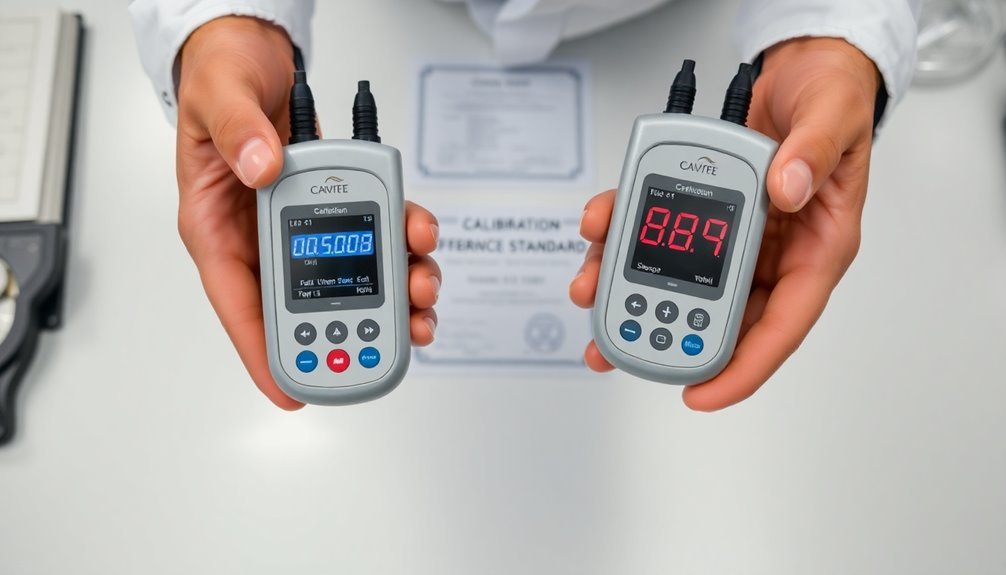
Maintaining strict performance standards remains essential when selecting a portable charge detection monitor system. You'll need to verify your system adheres to precise voltage and current thresholds for accurate detection and measurement. Your monitor must reliably handle voltage ranges on V BUS and implement proper detection protocols using specific current sources between 7µA to 13µA for initial detection on D+. The system should be capable of distinguishing between CDP and DCP ports through voltage and current testing procedures.
For peak performance, your detection monitor should meet these critical standards:
- Voltage compliance within 0.5V to 0.7V range for both D+ and D- during primary and secondary detection
- Current sink capabilities between 25µA to 175µA for D- and 50µA for D+ operations
- Ground offset tolerance of 375mV for CDP compatibility
- Accurate coulomb counting ability for reliable capacity tracking
You'll want to verify that your chosen system incorporates advanced battery monitoring features.
Look for systems that can handle variable load profiles and maintain accurate measurements despite temperature fluctuations. The monitor should integrate seamlessly with power management features while providing continuous current monitoring capabilities.
Remember that proper detection guarantees both safe operation and efficient charging performance throughout the system's lifecycle.
Power Delivery Configurations
You'll need to take into account standard USB-C voltage options ranging from 5V to 20V when selecting your charge detection monitor system's power delivery configuration.
Your system should handle current loads up to 5A for Standard Power Range operations, with compatibility for both legacy BC1.2 devices and modern USB-PD equipment.
The input source must support Power Delivery protocols to enable proper voltage negotiation and maintain stable power output across your testing scenarios. Smart charging solutions incorporate charging controller chips to automatically detect and optimize power signals for connected devices.
Standard Voltage Range Options
Understanding standard voltage ranges stands at the forefront of selecting a portable charge detection monitor system.
You'll need to take into account both battery specifications and power delivery capabilities to guarantee ideal charging performance and device safety.
Lithium-based batteries typically operate between 2.64V and 4.0V, with discharge ranges centered around 3.0V to 4.2V.
You'll want to use monitoring circuits like the MAX9065E that provide ±1% accuracy when paired with proper tolerance resistors.
USB-C Power Delivery offers standardized voltage options that you must factor in for your monitoring setup:
- Basic 5V output for standard charging needs
- Mid-range 9V and 12V options for faster charging capabilities
- Higher 15V and 20V settings for devices requiring more power
- Variable amperage options from 1A to 3.4A depending on device requirements
For accurate measurements, you'll need a USB Charger Doctor or similar tool that can handle voltage ranges from 3V to 7.5V with ±1% accuracy.
When testing power delivery configurations, verify your monitoring system can accommodate current variations up to 2.5A while maintaining 10mV voltage resolution for precise readings.
Maximum Current Load Limits
Building on voltage specifications, current load limits define the safe operational boundaries of portable charge detection systems. You'll need to understand that different USB standards provide varying levels of current capacity, which directly impacts charging capabilities and safety requirements.
For basic monitoring needs, you'll want to guarantee your system can handle the standard USB 2.0 configurations, which start at 100mA and can increase to 500mA after proper enumeration. If you're designing for higher power applications, your detection system must accommodate CDP and DCP specifications that deliver up to 1.5A without enumeration requirements.
When implementing modern USB-PD monitoring, your system needs to detect and manage power levels up to 240W through USB Type-C connections. You'll need to incorporate detection mechanisms for various voltage levels, including extended power modes at 28V, 36V, and 48V.
Your monitoring system should feature robust over-current protection and fault detection capabilities to prevent damage to connected devices.
Don't forget to include temperature monitoring features in your detection system, as power banks and charging devices require thermal management to maintain safe operation. Your system should also verify compatibility between power sources and devices to guarantee ideal charging performance.
Input Source Requirements
Selecting appropriate input source requirements forms the foundation of a reliable portable charge detection system.
You'll need to verify your power bank's input specifications align with your charging needs while considering voltage ranges and power delivery capabilities. The system's voltage comparators monitor these inputs precisely, triggering signals when voltage levels fall within acceptable parameters.
When evaluating input source requirements, you'll find that modern power banks offer various charging configurations through USB-C PD ports and multiple connection options. Your choice should account for both current and future device compatibility.
Consider these essential input source requirements:
- Match your power bank's input voltage range with your charging adapters and verify they're compatible with the voltage comparators in your detection system.
- Confirm the supported charging speeds (18W-100W) align with your devices' requirements and consider how faster charging might impact battery longevity.
- Check that the power bank's capacity meets your needs while balancing size and weight constraints.
- Verify the presence of essential safety features like overcharge protection and short circuit prevention, which work alongside the detection system.
Charging Algorithm Options
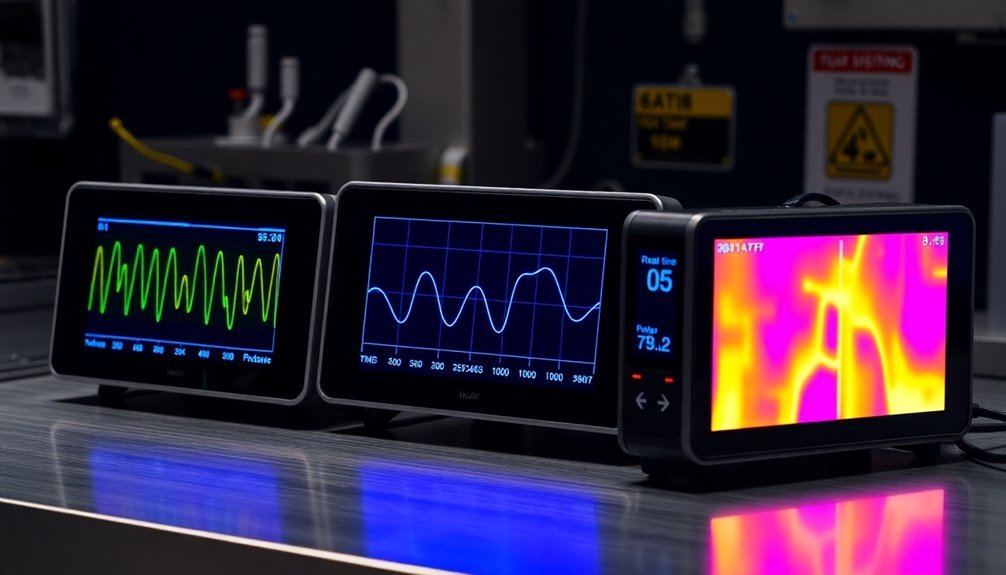
Your choice of charging algorithm must include smart adaptive current control to dynamically adjust power delivery based on real-time battery conditions.
You'll want a system that continuously monitors and modifies charging parameters to maintain ideal performance while preventing overcharging or thermal stress.
Temperature-based adjustments are essential, as they'll automatically reduce charging current when heat thresholds are approached, protecting both your battery and charging system.
Smart Adaptive Current Control
A well-designed portable charge detection monitor system relies heavily on its smart adaptive current control capabilities. The system's intelligence stems from its ability to continuously monitor and adjust charging parameters based on real-time battery conditions and user behavior patterns.
When evaluating smart adaptive current control features, you'll want to focus on these key elements:
- Flexible charging profiles that automatically adjust to your battery's state of charge, guaranteeing peak performance while preventing damage from overcharging.
- Real-time monitoring systems that track temperature, voltage, and current levels, making instant adjustments to maintain safe charging conditions.
- Learning algorithms that analyze your usage patterns and adapt charging strategies to match your specific needs.
- Advanced safety protocols that implement immediate corrective actions when detecting anomalies.
You'll find that effective smart adaptive current control combines both constant current (CC) and constant voltage (CV) charging methods, switching between them as needed.
The system should incorporate IR compensation for precise voltage control and utilize SoC thresholds to manage charging stages effectively. This adaptive approach guarantees your battery receives the most efficient charge while maintaining its long-term health and performance.
Dynamic Temperature-Based Adjustments
Through effective temperature-based charging algorithms, portable charge detection monitors maximize battery life while ensuring safe operation. You'll find that these systems automatically adjust charging parameters based on real-time temperature readings, maintaining the ideal 10°C to 30°C charging range. When temperatures fall outside this range, the monitor reduces charging current to prevent pressure buildup and potential venting.
| Temperature Range | Charging Adjustment | Safety Measure |
|---|---|---|
| Below -20°C | Minimal/No Charging | Thermal Blanket Required |
| -20°C to 10°C | Reduced Current | Temperature Compensation |
| 10°C to 30°C | Ideal Current | Standard Operation |
| Above 30°C | Decreased Voltage | Enhanced Monitoring |
Your charge detection monitor should implement a 3mV per cell voltage drop for each degree Celsius rise in temperature. This dynamic adjustment prevents overcharging in high temperatures and undercharging in cold conditions. Modern systems incorporate machine learning algorithms to calculate battery State of Health (SoH) and predict potential failures. You'll benefit from remote monitoring capabilities that alert you to temperature anomalies and adjust charging parameters automatically, extending your battery's life by up to 15% through proper thermal management.
Protection Circuit Design
Modern portable charge detection systems require robust protection circuits to safeguard both batteries and charging equipment. You'll need to focus on key components like MOSFETs, integrated circuits, and thermistors to create an effective protection system. These components work together to prevent damage from overcharging, over-discharging, and temperature fluctuations.
When designing your protection circuit, you'll want to implement these critical safety features:
- Overcharge protection that cuts off charging at 4.25V per cell
- Over-discharge protection that prevents operation below 2.7V
- Temperature monitoring systems that function from -40°C to +85°C
- Overcurrent protection using CSA and UVOV blocks
You should integrate your protection circuit with a battery management MCU to enable smart charging algorithms and provide backup protection.
It's vital to include safety timers to prevent extended charging periods and implement individual cell monitoring through high-voltage analog peripherals. Your circuit should support various charging modes, including trickle, pre-charging, constant current, and constant voltage.
Remember to incorporate programmable features that allow you to customize charging algorithms while maintaining hardware-based protection mechanisms.
System Compatibility Analysis
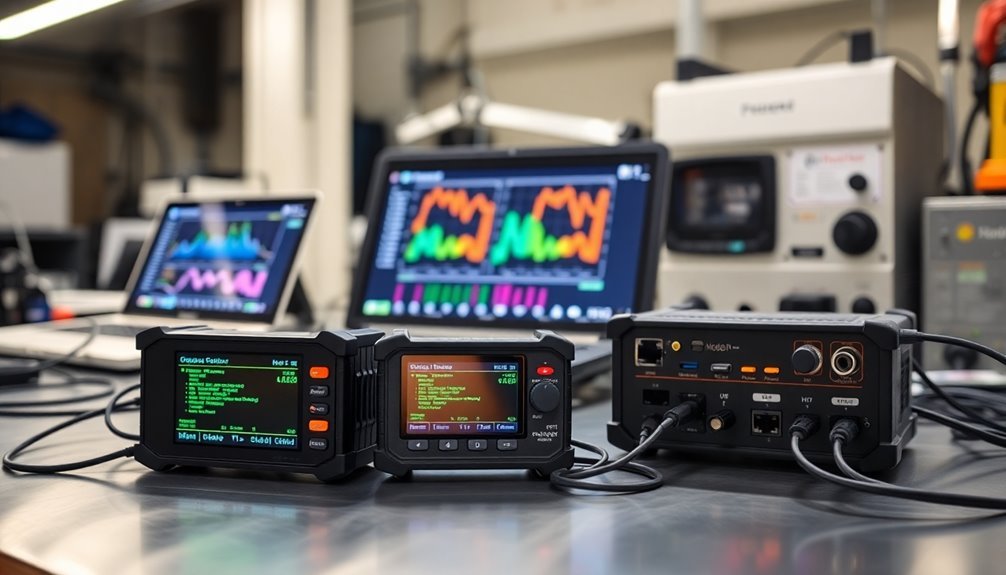
Your portable charge detection monitor needs to support various battery types, from traditional lithium-ion to emerging chemistries, ensuring broad compatibility with your devices.
You'll want to verify that the system adheres to common power interface standards like BC1.2, which enables accurate detection of CDP and DCP charging modes.
The monitor should also integrate seamlessly with your existing device protocols through TCP/IP communication and standardized HMI interfaces for real-time monitoring and control.
Battery Type Support Range
Portable charge detection monitor systems excel at handling diverse battery configurations, with extensive support for lithium-ion battery packs and other common types.
They're designed to work seamlessly with universal charging standards, guaranteeing you'll have the flexibility to monitor and manage various battery configurations, including 5-cell lithium-ion batteries.
Your monitoring system should provide thorough battery management capabilities through these essential features:
- Individual cell voltage monitoring for enhanced safety and longevity tracking
- Dynamic charging current adjustments based on real-time battery voltage measurements
- Support for multiple charging modes including trickle, pre-charging, CC, and CV
- Automatic detection of charger types with BC1.2 compliance verification
You'll find that modern portable charge detection systems integrate seamlessly with Battery Management Systems (BMS), allowing you to track battery health and performance history effectively.
The system's ability to adjust charging parameters dynamically guarantees peak charging efficiency while maintaining safety standards.
With built-in protection features like overcurrent prevention and voltage monitoring, you're assured of reliable operation across different battery types and charging scenarios.
Power Interface Standards
Building upon battery type compatibility, understanding power interface standards becomes fundamental for ideal charging performance. You'll need to ascertain your charge detection monitor supports various USB standards, from basic USB 2.0 to advanced USB-C Power Delivery protocols. These standards determine both charging capabilities and data transfer speeds for your monitoring system.
| Interface Type | Power Output | Key Features |
|---|---|---|
| Standard USB | 2.5W-4.5W | Basic monitoring, universal compatibility |
| USB-C (Non-PD) | Up to 15W | Fast charging, reversible connector |
| USB-C PD | Up to 240W | Advanced monitoring, variable voltage |
When selecting your monitor system, check for support of different port types: SDPs for standard data and power monitoring, DCPs for high-current charge detection, and CDPs for simultaneous high-current charging and data transfer. You'll want to verify the system's compatibility with various identification methods, including 15kΩ pulldown resistors for SDP/CDP detection and D+/D- short detection for DCPs. Consider whether your monitor needs to support EPR cables, which enable monitoring of extended power ranges up to 240W through USB-C connections.
Device Integration Protocols
System compatibility requirements demand careful attention to device integration protocols when selecting a charge detection monitor. You'll need to guarantee your chosen system aligns with established standards like CEN ISO/IEEE 11073 for seamless interoperability and IEEE 802.11 protocols for wireless connectivity. Understanding these protocols helps you avoid compatibility issues and guarantees efficient data exchange across your monitoring infrastructure.
When evaluating device integration capabilities, consider these essential factors:
- Protocol compatibility with your existing network infrastructure and management systems
- Support for standardized communication interfaces that enable plug-and-play functionality
- Security features that protect sensitive data during transmission and storage
- Remote monitoring capabilities for real-time system management
You'll want to look for systems that incorporate protocol-agnostic platforms and unified drivers, as these features notably reduce integration complexity. Consider solutions that comply with IHE PCD Technical Framework guidelines to guarantee proper semantic content handling.
Remember that while some monitors might offer proprietary protocols, standardized integration approaches typically provide better long-term value and reduced maintenance overhead. Pay special attention to environmental factors that could affect device performance and choose systems with thorough monitoring capabilities for effective troubleshooting.
Frequently Asked Questions
How Long Does a Typical Portable Charge Detection Monitor System Last?
You'll typically get 5-10 years from your charge detection monitor system, depending on your maintenance habits, usage patterns, and environmental conditions. Regular updates and proper care will maximize its lifespan.
Can These Systems Be Used in Extreme Weather Conditions?
Yes, you'll find these systems can operate in extreme conditions. They're built with high IP ratings, withstand temperatures from -40 to 60°C, and handle 0-100% humidity while maintaining reliable performance in harsh weather.
What Happens if the System Loses Power During a Monitoring Session?
If your system loses power, it'll switch to backup power through UPS or power bank systems. You'll receive notifications about the outage, and your monitoring data will be preserved through built-in failsafe mechanisms.
Are Firmware Updates Available for Older Monitor System Models?
You'll find firmware updates for many older monitor models, but availability varies by manufacturer. Check your specific model number, as some updates may be limited or unsupported for older systems.
How Many Batteries Can Be Monitored Simultaneously by One System?
You'll find varying capacities: BMS-3923 handles up to 6 cells, Victron SmartShunt monitors one battery bank, while you'll need separate units for individual battery monitoring in most other systems for accurate tracking.
In Summary
You'll get the most from your portable charge detection system by carefully evaluating the key components, safety protocols, and compatibility requirements we've discussed. Consider your specific monitoring needs, power delivery demands, and integration goals when making your selection. Don't forget to prioritize protection circuits and battery management features. With the right system, you'll guarantee reliable charge detection and peak performance.

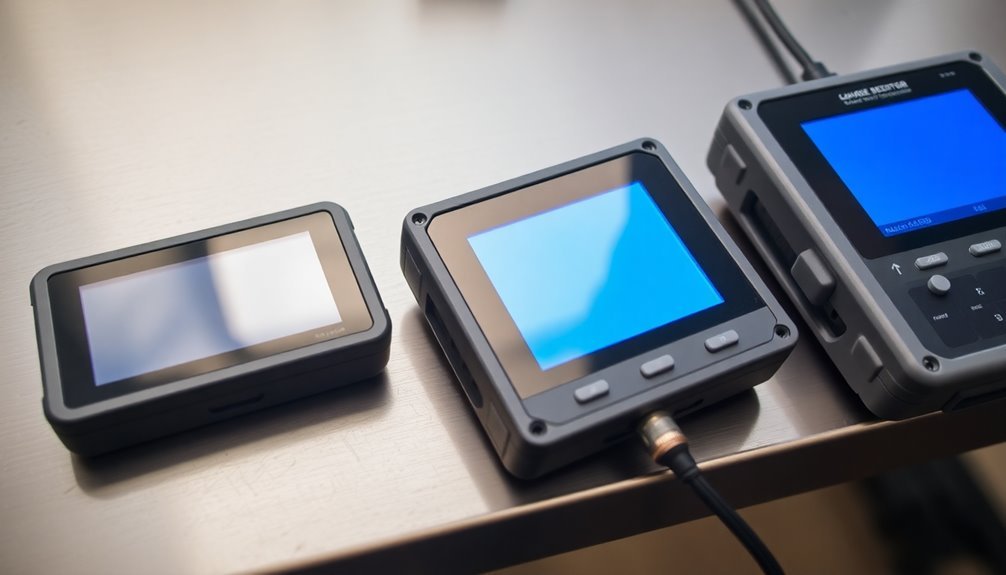



Leave a Reply